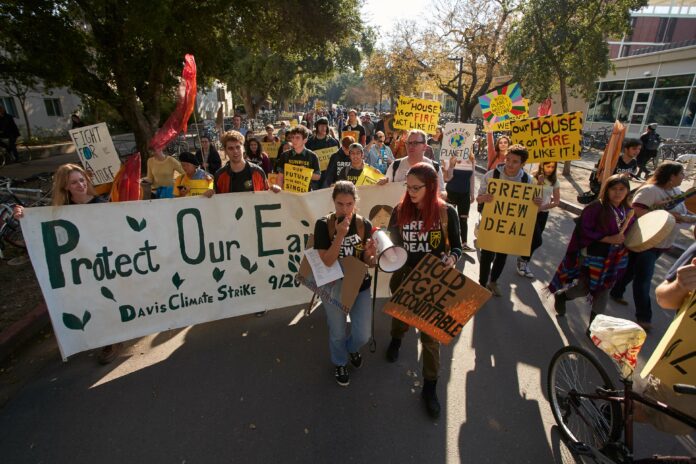Community members, students see different approaches to solving climate emergency
Fall Quarter 2019 at UC Davis started and ended with a climate strike. At noon on Dec. 6, the Davis chapter of the Sunrise Movement organized a climate strike in solidarity with Fridays for Future, which drew students and Davis community members to the Quad.
The strike began at the Quad but then moved to Central Park at 12:30. There, members listened to speakers “discuss the threat that climate change poses to our society and what we can do about it,” according to Sunrise Davis’ listing on the Patch website. Sunrise Davis members have striked every Friday since Sept. 20, the listing said.
Similar to the Sept. 20 and Sept. 27 strikes in Davis, organized by Davis High senior Amber Crenna-Armstrong and third-year environmental science and management major Megan Phelps, respectively, the Dec. 6 strike demanded action toward the climate crisis. The listing also called for California Governor Gavin Newsom to demand carbon neutrality by 2030 and advocated for the phasing out of fossil fuels. Strikers chanted “Hey, hey, ho, ho, fossil fuels have got to go!” in support of these aims.
At the Quad, strikers posed for a picture with a “Protect our Earth” banner before heading toward the park, and they held up signs with slogans like “Dear Democrats, Step Up or Step Aside” and “The Climate is Changing, So Why Aren’t We?”
Former Davis Mayor and current City Councilman Michael Corbett showed up to support the students who were striking. Corbett said he thought the city council should be doing more, citing Davis’ reputation as an environmentally friendly city that “broke ground across the world in the ‘70s,” in part for the 1972 Energy Conservation Building Code, which instituted mandatory energy conservation standards across all new construction.
“Right now, we want City Council to move faster,” he said, speaking generally about Davis community members in support of the strike. “We’re asking that they hire a senior staff level person in charge of making things get done that were planned eight or nine years ago.”
The City of Davis passed a climate emergency resolution meant to address climate change by 2030 in March and is drafting a 2020 comprehensive Climate Action and Adaptation (CAAP) update to the 2010 CAAP Plan, but Corbett also suggested that the city do more to reduce the carbon footprint created by cars.
In a 2012 Davis Community Greenhouse Gas Emissions Update, the city found that “more vigorous and potentially difficult mitigation measures pertaining to transportation behavior will likely be necessary to consider.”
Corbett emphasized top-down changes, which UC Davis is also trying to implement. In 2009, the campus said it aimed to be zero-waste by 2020, a goal it failed to meet.
A revised sustainability plan that sets more realistic goals is in the works, according to Dana Topousis, chief marketing and communications officer for UC Davis. ASUCD also passed a Climate Emergency Resolution, authored by Phelps and others on the Environmental Policy and Planning Commission. It stated that ASUCD stood in solidarity “with cities and college campuses across the United States in declaring a climate emergency.”
While community member Sue Barton agreed, saying policy leaders’ actions were important, she also said she thought these kinds of grassroots movements create power.
“The marches in the ‘60s forced the government to act,” Barton said. “It’s people getting out and expressing their concerns about what the future is going to look like for their kids and grandkids that will cause change.”
And Kimberly Evans, a third-year environmental science and management major who had previously striked on Sept. 27, said that it was important to start with grassroots movements for major issues like climate change.
“It was a simple argument that started making me reconsider my role: If I don’t do something, who do I expect to do something?” Evans asked.
Not everyone joined the strikers. Third-year biological sciences major Anthony Ramirez saw the strikers both arriving at and leaving the Quad but said he did not have time to participate in the strike and did not have previous knowledge about it.
“Maybe someday I would participate,” Ramirez said. “But right now, I just think it takes too much energy.”
And when the Sept. 20 strike — which began at the Mary L. Stephens library — was held, the Davis Unified School District published a statement “encouraging students to express their civic engagement through peaceful assembly and constructive activities on campus” and said district and “school staff will be dispatched to supervise students who leave campus.”
Despite mixed sentiments toward the strike and the actions needed to accomplish climate actions, Evans said she remains hopeful.
“Even if it’s nothing we can solve in one day, one week, or even a few years, the more people we can gather together to understand that it’s a problem, the better,” Evans said. “We might not be able to affect the policy-makers of today, but we can affect the people around us and the policy-makers of tomorrow.”
Written by: Janelle Marie Salanga — campus@theaggie.org





Alright, now how many of these people would also strike against nuclear power, thereby immediately discrediting any supposed commitment they have towards curbing climate change?